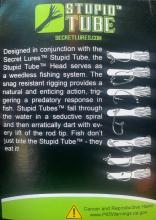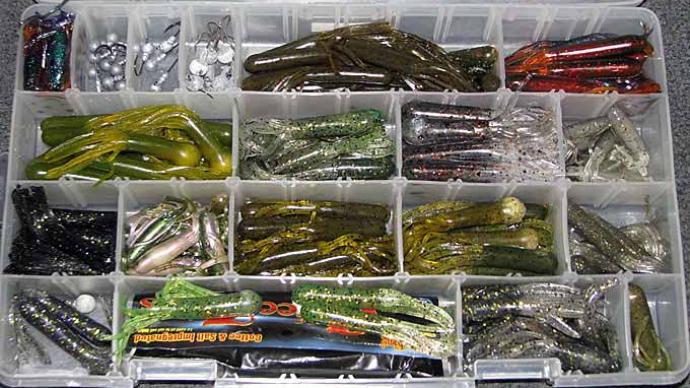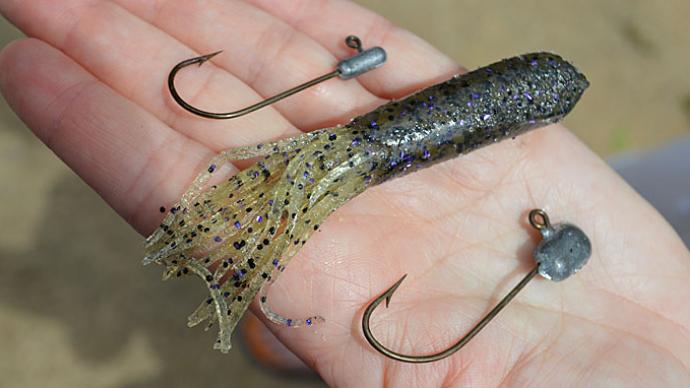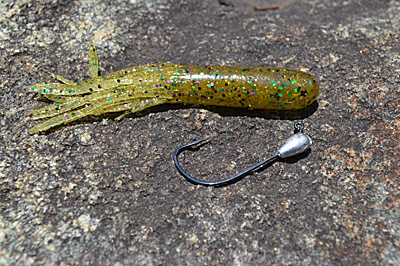
Matt McCoy was getting bites. But they weren’t getting in the boat.
It was the first day of the 2012 Bassmaster Classic, and McCoy was prepared. He found plenty of bites in practice by flipping and pitching big line, big hooks, and big soft-plastic lures to Louisiana’s Red River bass. The approach produced within the first five minutes of competition when he pitched to a stump. That bass made it almost to the boat before it shook the hook. He wasn’t worried: It was early, and there were plenty more bass to catch. Then the scenario repeated itself for the next several hours. Finally, he grabbed his favorite tube rig and salvaged the day by putting an almost 2-pounder in the boat.
McCoy, who qualified for that Classic as the top Northern Division Angler at the 2011 B.A.S.S. Federation Nation Championship, knew to start Day 2 where Day 1 ended. He threw his trusty Stupid Tube all day, accumulating 17 pounds and 7 ounces, the fifth heaviest five-bass stringer of that round.
The Classic wasn’t the first time McCoy found success with the Stupid Tube, which sports an internal jig head and Texas-rigged hook. It’s a longtime favorite of his fellow Indiana bass anglers. And he’s no different, taking it on the road, from Minnesota to the Gulf of Mexico, to catch smallmouth and largemouth.
Discovering its potential
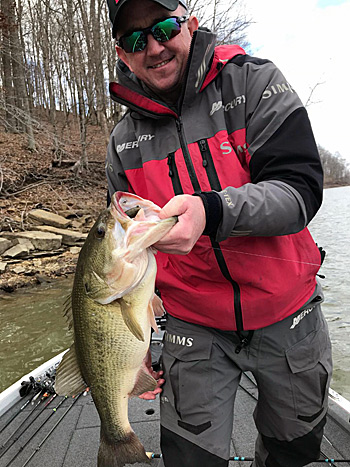
When McCoy began his bass-tournament career, he fished local events from his boat and Hoosier Division BFLs as a co-angler. In the former, he and his partner often found themselves just short of a win or out of the money. But when they discovered the Stupid Tube, their results improved. And as a co-angler, he regularly used it to catch bass from behind his boater. “I thought it was really special pretty quick,” he said. “I love to catch on topwaters, and I love to catch them on a 10-inch worm. But the Stupid Tube is responsible for my success.”
McCoy estimates more than three-quarters of his fishing time is spent with a Stupid Tube. “I’m a shallow-water fisherman,” he said. “I look for shallow-water bass all year.” It produced his biggest bass, an 8.41-pounder from Patoka Lake during a Hoosier Open on a cold and miserable March day. And last fall, during a BFL Super Tournament on Kentucky Lake, he ran to neighboring Lake Barkley, where he strained the shallows for enough weight to qualify for the 2020 BFL All-American Championship.
The Stupid Tube rig shines for two reasons. First, it retains the erratic gliding action and horizontal fall created by tubes with an internal jig head and open hook. But by rigging the hook Texas-style, it is snag-resistant. That allows McCoy to flip, pitch, or cast it anywhere he wants.
The Stupid Tube’s rigging provides one more benefit: McCoy can hang it without snagging the hook. Once wedged against a piece of cover, he applies some pressure through the line, causing the tube’s tails to rock up. And by applying and releasing pressure several times, he makes it move in place, resembling a crawfish, shad, or bluegill. A slightly firmer pull is all that’s needed to move it forward.
How to rig it
McCoy is no stranger to fishing a tube. He started fishing one as most anglers do on northern fisheries, inserting a lead head and leaving the hook point exposed. It worked great, generating many bites. But it also snagged often. His uncle had a better bass trap.
Terry McWilliams, who qualified through the Federation for the 2007 Bassmaster Classic on Alabama’s Lay Lake, where he fished the Stupid Tube to finish fourth, first showed his nephew a tube Texas-rigged on a lead head. He learned it from other Federation anglers; besides its rigging, it wasn’t anything special. But they were about to change that.

The first Stupid Tubes assembled by McWilliams and McCoy used whatever was handy. The lead head, for example, was the standard ball style. Then they started experimenting, from crimping split shot on a hook shank to embracing extra-wide gap hooks when they came on the market. “We did everything possible to make it better,” McCoy said.
McCoy said building a better Stupid Tube took about five years and plenty of trial and error, working alongside Indiana-based Secret Lures for most of that. They evolved to custom ones for their lead heads, starting with commercially available molds. For example, the heavy weight Ledge Head has a pitched weight that forces it to ride straight within a tube’s cavity when its hook is Texas rigged.
McCoy often uses Secret Lure’s 3/16-ounce lead head when fishing from “mud shallow” to 8 or 10 feet. He’ll use the 1/8-ounce version for targeting spooky spawners or when he needs a slower sink. It’s the same process for rigging a tube on any of the heads. First, insert the hook point into the tube’s cavity until it’s about the weight length from the top. Push the point through the tube’s wall, pulling it through to draw the weighted end of the lead head into the tube. Once it reaches the point where the hook exits, stop pulling and flip the lead 180 degrees. Push the hook back through the tube, Texas rigging it just in front of the tails, and finally, push the line tie through the head of the tube.
The Stupid Tube’s hook is “Texposed,” with only the tip tucked into the plastic. While that keeps it from snagging, it will release with little effort during a hookset. McCoy said that only happens with the right consistency of plastic, which he, McWilliams, and Secret Lures worked to perfect. If it’s too flimsy, the hook easily pops out and snags. But if it’s too tough, your hooksets suffer.
McCoy keeps his color choices basic. He rigs a green-pumpkin tube more than 90% of the time. “If I get real fancy, I’ll use a marker to put some chartreuse on it,” he said. He deviates from that choice a few times each year. He’ll choose a lighter shade of green when fishing around spawning bluegill, and in the fall, when bass are consumed with shad, he’ll throw some version of white.
Water color doesn’t affect McCoy’s color choice or stop him from throwing a Stupid Tube. When he started fishing what’s become his home water — Geist Reservoir, about 30 miles northeast of Indianapolis — its water was void of aquatic vegetation and dirty, almost the same green-pumpkin color of his tubes. “Surprisingly, [the Stupid Tube] works well in dirty water, even without a rattle,” he said. “You had to hit [bass] on the head. But they could see it and eat it, boosted my confidence.”
Where to fish it
While McCoy may swim his Stupid Tube along a submerged laydown, the rest of the time, he uses his rod to drag it, rocking it against any cover it comes across and picking up slack line with his reel. Don’t hop or snap it like a traditionally rigged tube. “The No. 1 thing is to stay in contact with what you are fishing,” he said.
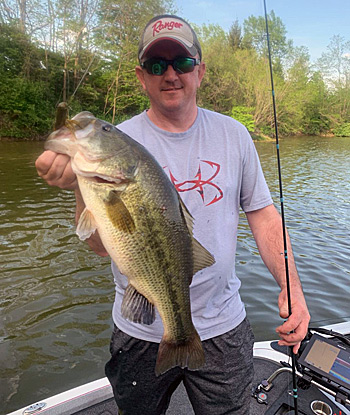
There isn’t a spot that McCoy won’t fish a Stupid Tube. “Docks, rocks, and wood — it’s my go-to,” he said. A stout line is needed to get it in and out of those places. He favors 15-pound fluorocarbon, which brings abrasion resistance and sensitivity. However, he uses 17-pound test in extra nasty situations such as shallow dock posts covered in zebra mussels.
The Stupid Tube doesn’t play well everywhere. McCoy said its rounded head struggles with thick aquatic vegetation. So, he switches to a Texas-rigged soft-plastic lure in that situation. And while he’s caught plenty of bass around flooded bushes with it, its relatively light weight and slow fall keep it from burrowing into their center. A heavy jig is a better choice there.
How to fish it
Some anglers, including McWilliams, throw the Stupid Tube on a spinning rod, especially when chasing smallmouth. It’s a beefier version of a standard tube rod, usually strung with 12-pound test line. But McCoy favors baitcasting gear. His favorite rod is a medium-heavy G Loomis NRX that measures 6 feet and 8 inches. “That rod seems short in today’s world,” he said. “But I can skip [my Stupid Tube] way up under stuff with it.”
McCoy said skipping a Stupid Tube, or any lure for that matter, across the surface and under obstacles with baitcasting gear takes practice. While his rod’s slower action makes it easier, backlashes were common when he first perfected his form. While inconvenient, some proved to be blessings in disguise.
While stopping to untangle a backlash, McCoy’s Stupid Tube would soak under a dock. And when he finally picked up his line, he’d often find a bass holding onto his lure. He reasoned that bass could see it from farther away in the clear water. And they used the time it sat to swim over. Now he applies that patience to his retrieve even when he doesn’t backlash.
When McCoy can see his Stupid Tube in shallow water that’s clear, he often watches bluegill gather around it as if they are double-dog daring each other to bite it. And almost always, when they scurry off, his lure slowly swims away. “You never see the bass,” he said.
More times than not, bites on a Stupid Tube feel like it’s hung, McCoy said. Or a bass will pick it up and swim toward you. “That just feels like you can’t find the bottom,” he said.
McCoy matches his hookset to how he’s fishing his Stupid Tube. If a bass bites on a long cast, he tightens the slack and makes a sweeping hookset, like with a Carolina rig. If a bass pulls his line around a limb or dock post, he leans back and starts reeling, like with a spinning rod, forcing the bass to swim in the other direction. If the bite comes closer to the boat, and there aren’t obstacles in the way, his hookset is a solid pop, like with a jig.
BassResource may receive a portion of revenues if you make a purchase using a link above.


